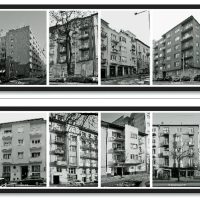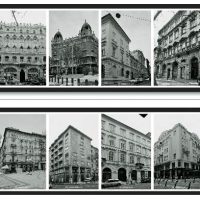Conspired flats were state property, and were visited by agents acting in important matters, as well as other roped-in individuals. Meeting flats were owned by private persons and were lent for operative actions and surveillance mostly out of “selfless patriotism” and “wholehearted helpfulness”.
Today the address list is available to all, but behind which doors in which stairway or corridor the secret meetings took place remains hidden in the murky shadows of past decades.
Based on the above information, Gábor Gerhes perambulated Budapest in the past months as a conscious flaneur. He returned to the “scenes of crime”, documenting the facades of unknown blocks of houses where once secret agents, spies and informers used to meet. In an austerely accurate and suitably removed manner, he used the typology familiar from the Bechers to record a strange, banal city guide where seriality and uniform representation draw up a faceless inventory of the recent past.
Similarly to cartography, photography is made up of visual signs: at first sight, both objectively represent their environment, but there is as much mystery inherent in their semiology as visibility offered by it. Gábor Gerhes replaces abstract geographical signs with descriptive black and white photographs, thus evoking the non-image underlying the representation: forgotten phantoms of Budapest, lurking in the shadows of the photographs. Faithful to himself, he builds on our partial knowledge: he reveals and veils at once, stimulating passage between our real knowledge and our imagination.

